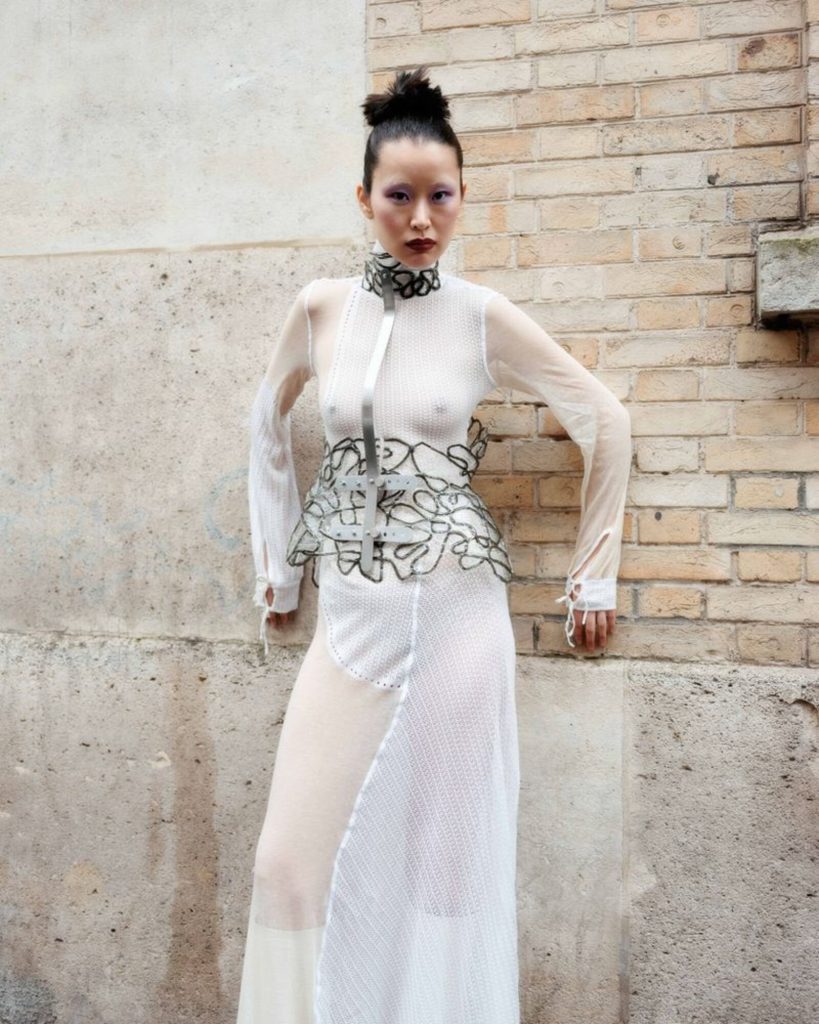The world of rebellion and refinement, where creativity knows no bounds and tradition dances with innovation opens for the new generation. Nestled within the prestigious halls of Institut Français de la Mode (IFM), Master of Arts students are here to redefine the landscape of fashion design. In this electrifying interview series, we peel back the layers of inspiration, aspiration and sheer determination driving rising female designers forward. Join us as we roam through the bustling streets of Paris to talk about how tradition meets innovation and the future of fashion unfolds in every stitch.
hube: Could you tell us about your journey into the world of fashion design? What sparked your interest in pursuing a career in this field?
Eva Risueño: Well, my journey into the world of fashion design began in a small knitting club in the Canary Islands. I’ve always been drawn to textiles and the art of creating something beautiful with my hands. Knitting was my first love, and as I delved deeper into the craft, I found myself captivated by the endless possibilities of fashion design. The way a simple skein of yarn could transform into a stunning garment fascinated me, and I knew I wanted to explore this passion further. So, I began experimenting with different stitches, patterns, and techniques, immersing myself in the world of fashion design one stitch at a time. From that small knitting club to dreaming of showcasing my own creations on the runway, my journey has been one of creativity, exploration, and endless inspiration.
Keyin Wang: I did my Bachelor of Fashion Design at the Pratt Institute of New York. Then, I directly started the Master Knitwear programme at IFM. All the female members of my family have been involved in the fashion industry since I was very young. I didn’t have a lot of friends to spend time with at that time, so I always stayed with my family and watched them work. They deeply influenced my decision to join the world of fashion.
Laura Arbault: My passion for fashion was born during secondary school when I started to make my own clothing choices. At the time, I was passionate about metal music. So I naturally developed an alternative style that straddled the line between gothic, punk, and heavy metal. And it’s a clothing heritage that still nourishes me today. I started cutting up my t-shirts and filing and ripping holes in my jeans. I also did a lot of styling, combining pieces to create slightly offbeat looks, sometimes mixing different worlds. It was then that I realised the power of fashion and became passionate about it. I saw it as a unique medium of expression, a way of writing about yourself in the public space. Fashion helped me to build my identity and assert myself in society without having to do it through words. It was these early experiments in textiles and clothing that made me want to pursue a career in fashion later on. I first studied textile design, then fashion. And it was this dual passion for material and shape that led me to specialise in knitwear. I really wanted to be able to make my designs from A to Z, starting with a raw material, a simple yarn, and ending up with a final piece in volume. Alongside my studies, I discovered the world of fashion from the inside during my various internships, and in particular during my work placement at Balmain, in the knitwear studio. What made me want to be part of this industry is the effervescence of the fashion world. I like shaking up codes, I like the idea that a garment can unleash passions, both positive and negative. I love this industry because it brings something to people. I don’t pretend to think that it’s indispensable; I’m well aware that we do not save lives. But creativity, beauty, and commitment are things that make people’s lives more beautiful, more fun, and more powerful.
Marion Pelle: I started my university studies in fine art. I did my BA at La Sorbonne. I always wanted to have an artistic career, I love art in all its forms but I chose to specialise in fashion because of my relation with the body, the norms, and garments. I did a BA in fashion design at Duperré and an MA in knitwear at IFM.
Sofia Saerens: I have spent my teenage years absolutely certain that I would pursue an artistic path, I just was not sure about which medium I would go for. Just like many of us designers, I think it started when I realised there was a sewing machine at home, and it became a tool of creation just like my pencils or cameras. Back then I did not think twice about what attracted me to fabric and clothes, but looking back I think it is all about the sensitivity of the materials, touch is an important part of why I like making clothes. Also, garments are such a huge part of everyone’s everyday life, I like the fact that potentially my designs could be seen by anyone from anywhere, there is an accessibility to fashion that you don’t find in other artistic mediums shown in art fairs and museums.


